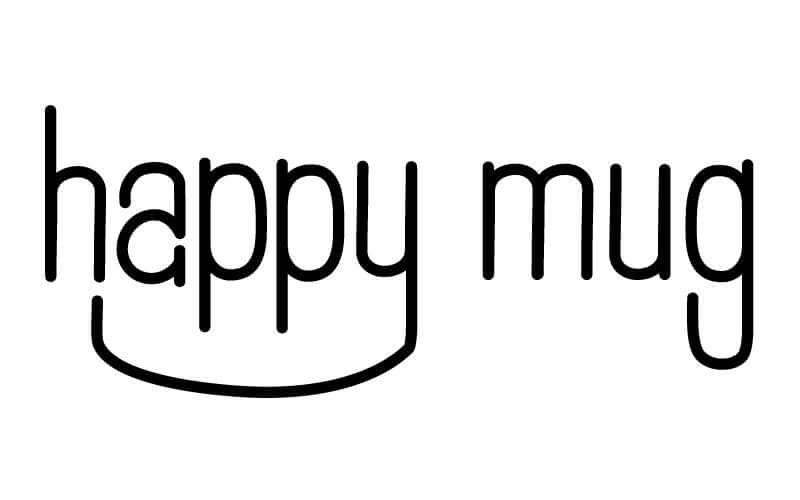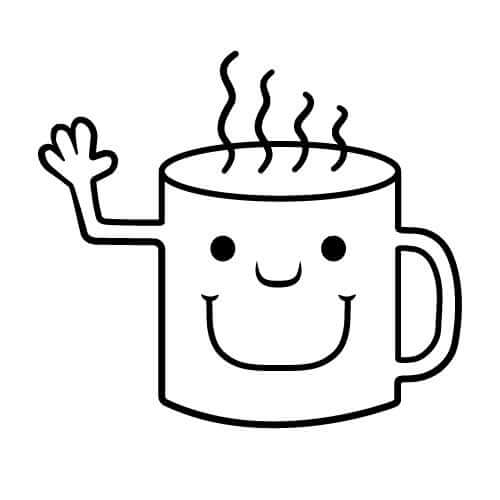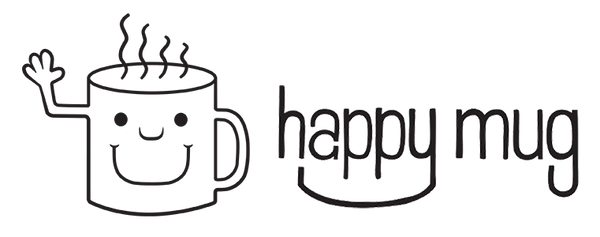Frequently Asked Questions
Do you have a storefront/cafe?
We do not have a physical storefront where you can walk in and buy coffee, nor do we have a cafe. All orders must be placed through our website, and can be selected as a "pickup". You will then be emailed when your order is ready, and you can come pick it up at our roastery!
What’s your return policy?
At Happy Mug, we want every mug to be happy with our coffee! If you have any issues with your order, we're here to help.
Shipping Information
- Orders are typically processed within 1 day and shipped via [USPS, FEDEX, OR UPS].
- Shipping costs vary based on weight and location. Free shipping is available for orders that contain only ROASTED COFFEE or TEA and exceed $40. Green Coffee orders are shipped by weight. You will receive a tracking number once your order ships.
Returns & Satisfaction Guarantee
We take pride in our coffee and want you to love it as much as we do. If you're not satisfied, let us know—we'll work something out!
- Wrong Item Received? If we made a mistake with your order, we will issue store credit or we’ll send you the correct item at no additional cost.
- Other Issues? If there’s another reason for the return, we ask that customers cover return shipping costs.
- Refunds & Replacements: Reach out to us within 15 days of receiving your order, and we’ll make it right with a refund, exchange, or store credit.
For any questions or concerns, contact us at -
Email: mug@happymugcoffee.com
Phone: 814.547.3462
What is “responsible” coffee?
It means a lot of things. We ONLY buy and sell responsible coffee. When you support mass market coffee you are quite likely supporting the following: pesticides on your coffee, growing practices which hurt wildlife, starving farmers who are treated like slaves with all the profit going to greedy foreign landowners. Responsible coffee means that the farm is friendly to the earth, the farmers are treated well, and only natural (if any) pesticides are used.
What kind of roaster do you have?
An American made steel drum roaster custom built by the fine folks at US Roaster Corporation in Oklahoma City. It weighs about 900 pounds and roasts up to 12 pounds at a time.
Where do you roast?
Our shop is in Erie, PA a couple miles away from the Great Lakes. You’re welcome to come visit and learn about coffee, but you need to give us a heads-up first. We operate on very tight deadlines and don't always have time to show you around if we're not expecting you.
When do you roast?
Pretty much non-stop from 8am to 2pm, right before mail packages are picked up for the day. Coffee is at its peak freshness for the first month, and we don’t want the clock to start ticking until it has to. Then we roast in the evenings and overnight to prepare large orders for delivery the next day.
What’s the best way to store coffee?
Why are you storing coffee? It’s best fresh. But okay, the best way is to store it away from light and air. The Airscape is a stainless steel canister we are fond of. If you aren’t going to drink the coffee in the next 30 days, go ahead and freeze it, but only in an airtight container, and only thaw it once. Whole bean is preferable to ground.
Why do you discourage people from buying pre-ground coffee?
The single best way to improve your coffee is to grind it yourself. Ground coffee is exposed to air 100 times more than whole bean coffee, and air is coffee’s worst enemy.
What’s the best way to brew coffee?
You should brew it the way you like it! But there are two keys to remember.
1) GOOD WATER. Coffee is 98% water, so if your water has off-tastes, so will your coffee. In addition, if your water has minerals and lime in it, it will damage your coffee pot over time.
2) Enough Coffee. A good starting point is 1 ½ tablespoons of coffee for every “cup” of water. And a “cup” of water equals 5-6 ounces for most pots. If you really want to taste every nuance in the coffee, using 2 tablespoons per cup is recommended, although this will seem strong to most people.
What kind of filter should I use?
The best way to pull out the hidden flavors of coffee is by using a metal filter. A Frenchpress, percolator, or espresso maker have metal filters and offer deep, complex undertones. A paper filter does the best job of removing these oils, but the oils contain some of the flavor! However, consuming the oils from coffee has been linked to higher cholesterol. We would suggest using a non-bleached (brown) paper filter foreveryday, and pulling out the Frenchpress on weekends for particularly special coffees. There are many other great options, like theHariodripper and theAeropress, but these are more for coffee geeks, and less practical for the average person who just wants a mug of coffee.
How can I roast coffee at home?
There are a variety of clever methods you can learn about on the internet. Everything from an iron skillet to a popcorn popper to a rotisserie over your grill to actual coffee roasting machines. No matter how you do it, you’ll get the freshest coffee possible by roasting it yourself. But if you really want to learn the craft of roasting coffee, I recommend the Hottop roaster. It’s a miniature drum roaster that roasts ½ a pound at a time and gives you control over the roast, just like a $20,000 commercial roaster would.
Why is your green coffee so cheap?
Don’t be fooled by the cheap prices. We keep our overhead very low and do everything possible to keep prices affordable for our customers. But we only sell the top 3% of coffee in the world, and won’t offer it if it isn’t that good. In many cases it's the top 1% of any given origin. We sample, sample, sample, ask way too many questions, and eventually find the lots that are great values. On the open market, more expensive coffees do not equal better tasting coffees - it's really a game of hide and seek. Having good relationships and connections helps us do the finding.
We also don’t believe that we should be getting more of your money than the farmers who grew it. Did you know the price of really good coffee, paid to the farmer, hovers in the one- to two-dollar range? Add freight, USA import fees, and a profit for the broker, and you’ve doubled the price. But then, our competitors often double or triple that price yet again when they sell it to you (and they try to tell you that your money is helping a farmer!) Don’t worry about our low prices. It’s the best coffee money can buy, and you’re supporting neither greed nor unsustainable farming when you buy it through us.
Why is your roasted coffee so much more expensive than your unroasted coffee?
We’re still quite a bit cheaper than most microroasters, but roasting coffee is an expensive process. First of all, when you roast coffee, it loses up to 20% of its weight. Add the equipment expense, maintenance, gas and electric to run the roaster, general business expenses. Add the labor spent roasting and packaging it. Add the cost of packaging, labels, delivery, and marketing. Add a touch more for quality control (it can take several batches of bad coffee before you find the perfect roast level) -- and it all adds up.
Where do you buy unroasted coffee?
Unfortunately, the only places in North America capable of growing coffee are Hawaii and Puerto Rico. There’s no such thing as “local” raw coffee. When possible, we buy directly from farmers who warehouse their crops in the US and ship to roasters on request. Sometimes we buy it from largeroasterieswho have purchased entire crops from a farmer and have more than they need. The rest of the time, we buy it from brokerages who can handle the customs paperwork, currency conversions, and language barriers involved. No matter what the source, coffee comes in burlap sacks with 132 -150lbs of green coffee inside.
Which coffee has the most caffeine?
Caffeine content varies greatly from bean to bean, even on the same plant. No one coffee origin is predictably higher in caffeine than any other. And while dark roasts do have slightly less caffeine by volume, they have slightly more caffeine by weight (dark roasts weigh less, so depending on whether you use a scale or a scoop depends on whether you get more or less caffeine in a dark roast, but roast level is really a negligible factor). Robusta coffee varietals have about double the caffeine of Arabica. Robusta coffee is not considered a specialty coffee, having a rubbery aroma and a rather empty taste.
How is coffee decaffeinated?
Coffee can be decaffeinated through chemical reaction (MC) or by a complex “water process” The chemical reaction is inexpensive and retains the majority of the coffee’s flavors. Since the chemical has a “flash point” of 102 degrees, and the bean is roasted to 400 degrees, no trace of chemical is left. "Water process" is more expensive, but completely natural. The Swiss Water Process (SWP) plant in Canada has been around a long time, but the newly built Mountain Water Process (MWP) plant in Mexico is swaying decaf drinkers with retained flavor. Happy Mug carries MC coffees at a lower price point for budget-minded customers, and the more pricey MWP coffees for the purists.
Is there really a coffee that is picked out of the excretion of animals?
Yes, there are several versions. The idea is that the animal eats the coffee bean, processes it through its system, and is then gathered, washed, and roasted, and then sold as a gourmet delicacy coffee. The Kopi-Luwakfrom Indonesia is the most famous, and is collected from the droppings of a possum-like marsupial called aluwak. But elephants in Africa and birds in Brazil are in on the action as well. The practice is highly surrounded by fraud, and unless you are right in the country, there is no way to know that your coffee really is authentic (it sells for $100 a pound and higher). Furthermore, the animals are often eating Robusta beans, and the coffee quality is poor. Aside from the novelty of it, you’re really not missing out, but the question comes up frequently, so that’s the scoop on that!
What if my package is lost/delayed in the mail?
Email us and let us know. Please do not ask us to submit a claim unless the package has been lost for 15 days or more. Carriers do not allow us to submit claims until after that time.
My package is marked as "delivered" but is not here! What do I do?
If your package is marked as "delivered" via tracking, we recommend checking around your home or building, consulting with neighbors, and contacting your local post office.
If these options fail, send us an email and we will happily contact a representative of whichever postal service delivered your package.
Please note that we cannot submit claims in this instance as they get denied. The recipient must submit a claim for it to be accepted.


